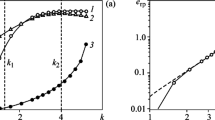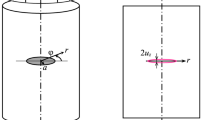Abstract
We show, by numerical simulations on crack arrays, that there is no stable quantitative correlation between strength of a brittle microcracking material and its effective elastic stiffness. The reason is that fracture processes are controlled by “details” of microcrack field geometry – such as local clusters of closely spaced cracks – to which the stiffness, being a volume average quantity, is almost insensitive.
Similar content being viewed by others
References
Caiulo, A. P. (2009) Numerical analyses of possible correlations between fracture and the effective stiffness in a brittle solid material, M.S. Thesis, Tufts University.
Cotterell B., Rice J.R. (1980) Slightly curved or kinked cracks. International Journal of Fracture 16(2): 155–169
Kachanov M. (1987) Elastic solids with many cracks: a simple method of analysis. International Journal of Solids and Structures 23(1): 23–43
Kachanov M. (1994) On the concept of damage in creep and in the brittle–elastic range. International Journal of Damage Mechanics 3: 329–337
Kachanov, M. (1993) Elastic solids with many cracks and related problems, in Advances in Applied Mechanics (ed. J.W. Hutchinson and T. Wu), Academic Press, 30, 259–445.
Kushch V.I., Shmegera S.V., Sevostianov I. (2009) SIF statistics in micro cracked solids: effect of crack density, orientation and clustering. International Journal of Engineering Science 47: 192–208
Kushch V.I., Sevostianov I., Mishnaevsky L. (2009) Effect of crack orientation statistics on effective stiffness of mircocracked solid. International Journal of Solids and Structures 46: 1574–1588
O’Brien T.K., Reifsnider K.L. (1977) Fatigue damage: Stiffness/strength comparison for composite materials. Journal of Testing and Evaluation 5: 384–393
Reifsnider, K. and Stinchcomb, W. (1983) Stiffness change as a fatigue damage parameter for composite laminates, Advances in Aerospace Structures, Materials and Dynamics, ASME (Ed. U.Yuceoglu et al), 1–6.
Sevostianov, I. and Kachanov, M. (2010) Local minima and gradients of stiffness and conductivity as indicators of strength reduction of brittle–elastic materials, International Journal of Fracture, DOI 10.1007/s10704-010-9485-6 (This issue).
Sevostianov, I, Zagrai, A, Kruse, W.A. and Hardee, H.C. (2010) Connection between strength reduction, electric resistance and electro–mechanical impedance in materials with fatigue damage, International Journal of Fracture, DOI 10.1007/s10704-010-9487-4 (This issue).
Author information
Authors and Affiliations
Corresponding author
Rights and permissions
About this article
Cite this article
Caiulo, A., Kachanov, M. On Absence of Quantitative Correlations Between Strength and Stiffness in Microcracking Materials. Int J Fract 164, 155–158 (2010). https://doi.org/10.1007/s10704-010-9486-5
Published:
Issue Date:
DOI: https://doi.org/10.1007/s10704-010-9486-5




